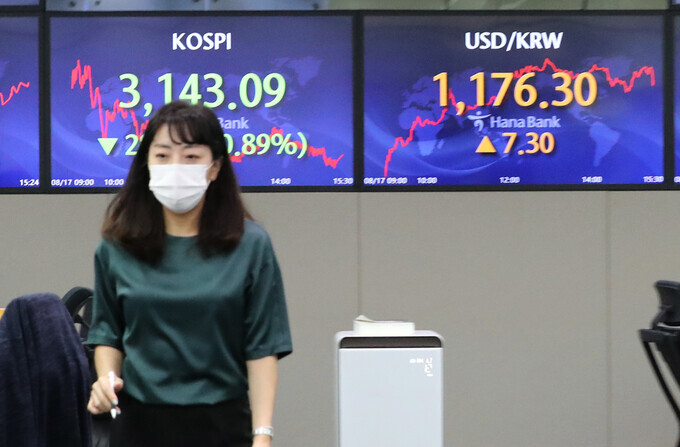hankyoreh
Links to other country sites 다른 나라 사이트 링크
S. Korean won falls to 1,176 against dollar, lowest in 11 months

The won-to-dollar exchange rate finished at 1,176.3 on the Seoul foreign exchange market Tuesday after jumping by 7.3 — indicating a steep drop in the won’s value.
It’s the highest the rate has been since Sept. 15 of last year, when it reached 1,179 won to the dollar. Over the past six trading days, it has risen by 34.2.
On Tuesday, foreign investors registered net sales of 417.7 billion won (US$357.32 million) on the KOSPI market. This was down sharply from the previous trading day when sales amounted to 2.7 trillion won (US$2.31 billion).
The numbers reflect a steep decline in sales of semiconductor stocks. In the case of Samsung Electronics, net sales totaled 454.4 billion won (US$388.75 million), down from 2.3515 trillion won (US$2.01 billion) the day before.
SK Hynix recorded net purchases for the first time in nine trading days, although the level was low at 62.8 billion won (US$53.73 million).
But this was not accompanied by a similarly smaller decrease for the indexes. The KOSPI finished the day down 28.2 points, or 0.89%, at 3,143.09 — its lowest level since May 17, when it reached 3,134.52. In the KOSDAQ’s case, the decline only increased, as the index finished the day down 29.73 points (2.86%) at 1,011.05.
Experts attributed this to the market effects of concerns about a semiconductor slowdown, combined with weak economic indicators in China.
The day before, China announced July retail sales and mining/manufacturing production figures that fell well below market expectations, with respective increases of just 8.5% and 6.4% compared with the year before. This has led some analysts to predict Chinese authorities will come out with fiscal and monetary policy support measures.
“Taken together, the tight money approach in the US and easy money approach in China could cause the won-to-dollar exchange rate to reach as high as the 1,180–1,190 range as the dollar strengthens,” predicted Moon Hong-cheol, an analyst at DB Financial Investment.
But others predict the won’s steep decline will not last for long.
“We need to prepare for the possibility of DRAM prices falling, but since there wasn’t a super cycle in the first place, the inventory adjustment period won’t be long and the influence will be minor,” predicted Lee Seung-woo, an analyst at Eugene Investment.
Kwon A-min, an analyst at NH Investment & Securities, said the trend “overly reflects fears that the rate of increase in semiconductor exports will drop off.”
“There’s a good chance the won-to-dollar exchange rate will fall again once the selling spree by foreign investors settles down,” she said.
By Han Gwang-deok, finance correspondent
Please direct comments or questions to [english@hani.co.kr]

Editorial・opinion
![[Column] Season 2 of special prosecutor probe may be coming to Korea soon [Column] Season 2 of special prosecutor probe may be coming to Korea soon](https://flexible.img.hani.co.kr/flexible/normal/500/300/imgdb/original/2024/0426/3317141030699447.jpg) [Column] Season 2 of special prosecutor probe may be coming to Korea soon
[Column] Season 2 of special prosecutor probe may be coming to Korea soon![[Column] Park Geun-hye déjà vu in Yoon Suk-yeol [Column] Park Geun-hye déjà vu in Yoon Suk-yeol](https://flexible.img.hani.co.kr/flexible/normal/500/300/imgdb/original/2024/0424/651713945113788.jpg) [Column] Park Geun-hye déjà vu in Yoon Suk-yeol
[Column] Park Geun-hye déjà vu in Yoon Suk-yeol- [Editorial] New weight of N. Korea’s nuclear threats makes dialogue all the more urgent
- [Guest essay] The real reason Korea’s new right wants to dub Rhee a founding father
- [Column] ‘Choson’: Is it time we start referring to N. Korea in its own terms?
- [Editorial] Japan’s rewriting of history with Korea has gone too far
- [Column] The president’s questionable capacity for dialogue
- [Column] Are chaebol firms just pizza pies for families to divvy up as they please?
- [Column] Has Korea, too, crossed the Rubicon on China?
- [Correspondent’s column] In Japan’s alliance with US, echoes of its past alliances with UK
Most viewed articles
- 1‘We must say no’: Seoul defense chief on Korean, USFK involvement in hypothetical Taiwan crisis
- 2Is Japan about to snatch control of Line messenger from Korea’s Naver?
- 3Up-and-coming Indonesian group StarBe spills what it learned during K-pop training in Seoul
- 4The dream K-drama boyfriend stealing hearts and screens in Japan
- 5[Column] Park Geun-hye déjà vu in Yoon Suk-yeol
- 6[Editorial] New weight of N. Korea’s nuclear threats makes dialogue all the more urgent
- 7[Editorial] Korea’s surprise Q1 growth requires objective assessment, not blind fanfare
- 8[Editorial] Statue should not be central concern of comfort women issue
- 9S. Korea “monitoring developments” after report of secret Chinese police station in Seoul
- 10The harrowing real-life stories of the Korean military coup depicted in “12.12: The Day”